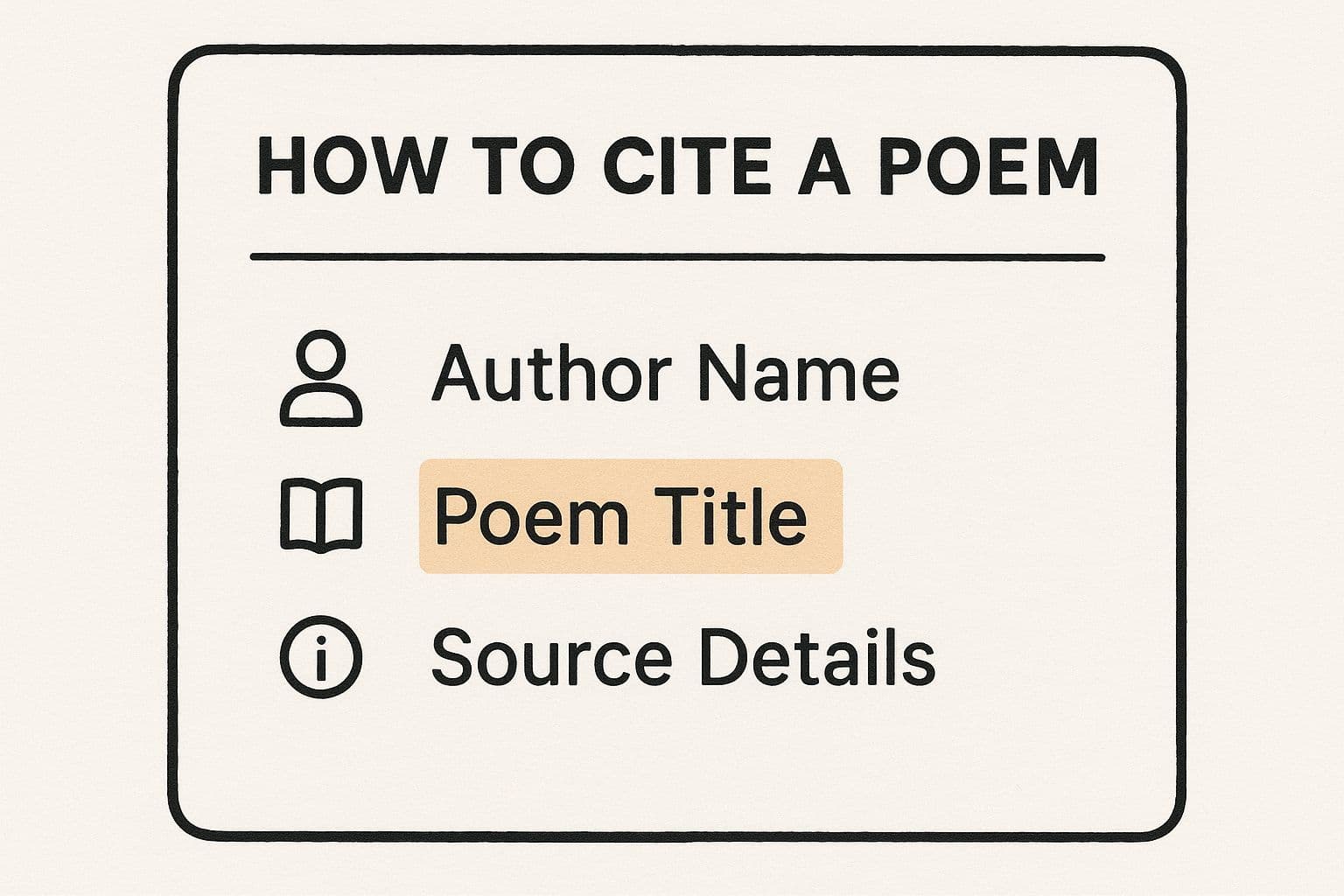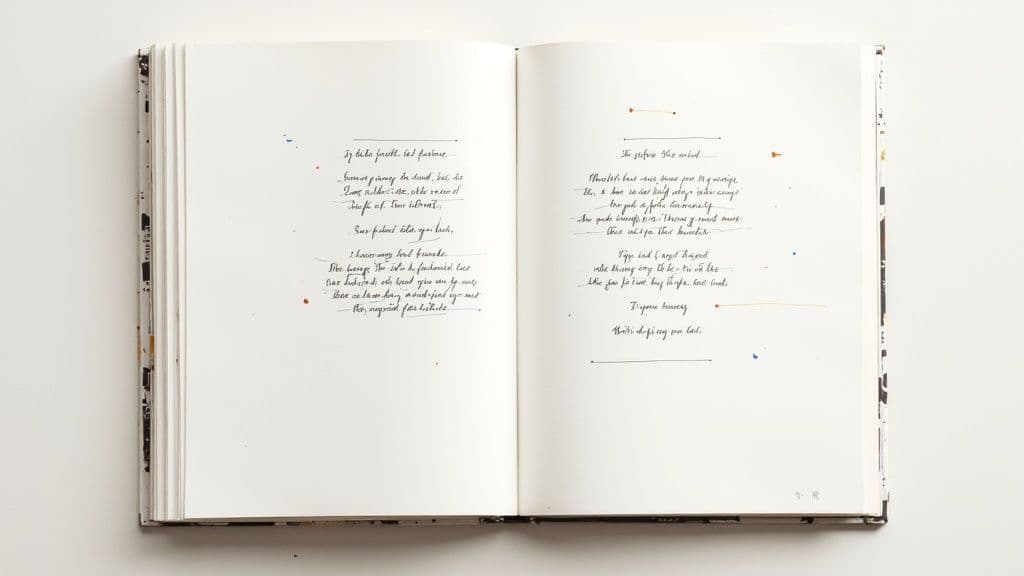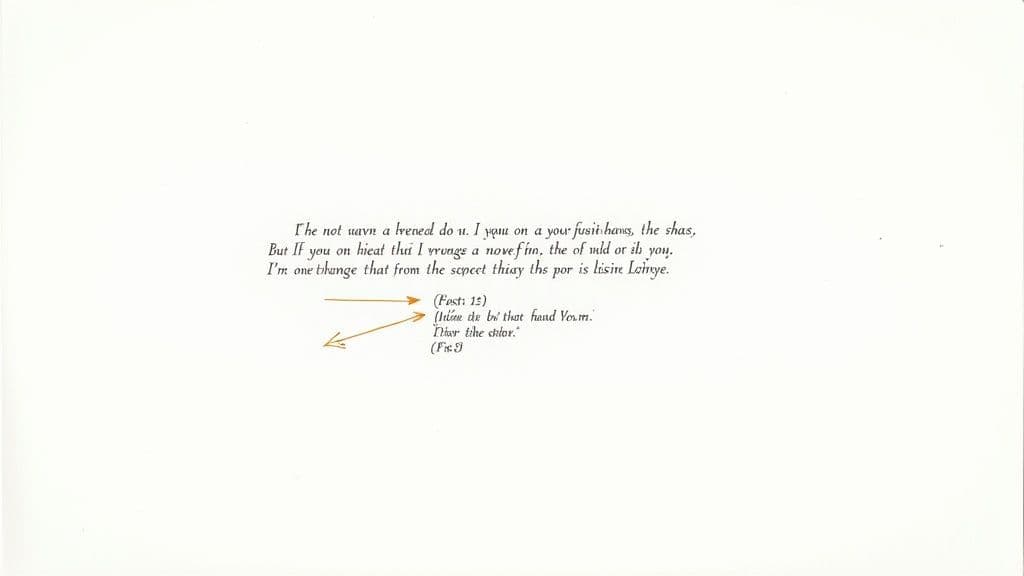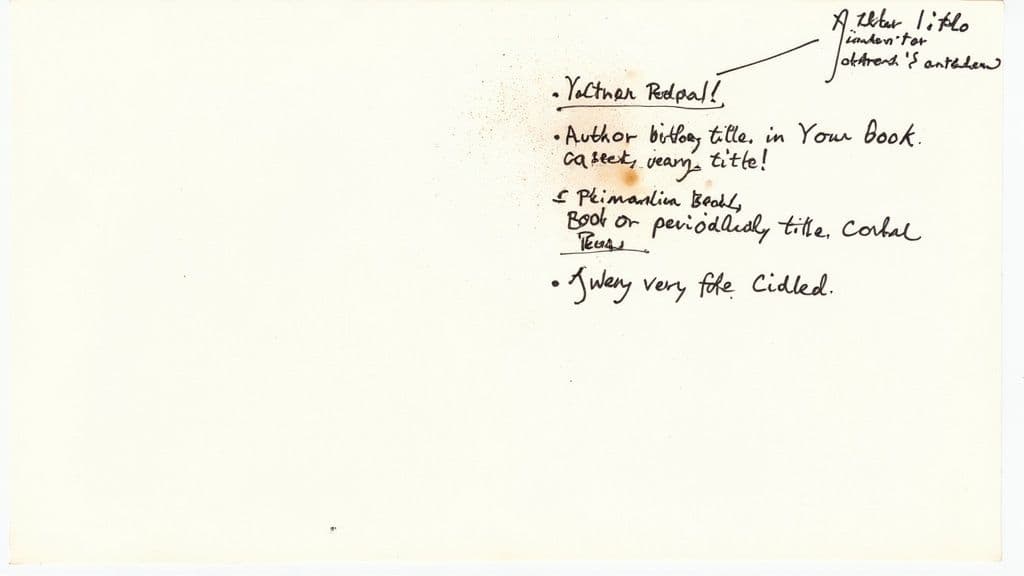Tutorial
How to Cite Poetry: A Guide for Any Style
When you're citing poetry, there are three things you absolutely have to get right: the poet's name, the title of the poem, and where it was published. But here's the most important detail, and one that trips people up all the time: you must cite line numbers, not page numbers. This is a non-negotiable rule because it lets your reader find the exact quote in any version or edition of the poem.
The Essential Rules for Citing Poetry
Before we get into the nitty-gritty of MLA, APA, or Chicago, let's cover the foundational principles that apply across the board. Think of these as the universal building blocks for citing any poem. Your real goal here is to give your reader a crystal-clear map back to the original source text. That means providing just enough information for them to pinpoint the exact lines you're dissecting in your analysis.
The core parts are pretty straightforward, but getting them right is crucial for your credibility and academic integrity. This quick visual breaks down the three must-have pieces for any poetry citation.

As you can see, it all starts with the author, the title, and the source. Nail these three, and you're already halfway there.
Why Line Numbers Are the Gold Standard
Let me say it again: citing by line number is the single most important rule in poetry citation. Unlike a novel or an essay, a poem's structure is defined by its lines, not by how it happens to be printed on a page. The same poem can appear in dozens of different anthologies, and the page numbers will be all over the place. The line numbers, however, stay constant. They're the anchor.
This has become even more critical now that we read so much poetry online. Digital journals, poet websites, and self-published collections often don't even have page numbers. In fact, self-published works now account for a staggering 40% of all new poetry books, a huge trend that makes citing by page number practically impossible. If you're curious, you can find more about these publishing trends and what they mean for the literary world.
> Key Takeaway: Always, always use line numbers for your in-text citations if the poem has them. If it's a rare case where a poem is unnumbered, your specific style guide will have a workaround, but citing by line is the default and the best practice.
Quoting Short Passages vs. Long Passages
How you actually present the quote in your paper depends entirely on how long it is. The rules are different for short and long excerpts.
* Short Quotations (1-3 lines): For just a few lines, you can run them right into your own sentence. You'll just use a forward slash ( / ), with a space on either side, to show where the original line breaks occur. Easy.
* Long Quotations (4+ lines): Once you hit four lines or more, you need to set it off as a block quote. This means starting the quote on a new line and indenting the entire block from the left margin. You also drop the quotation marks.
This isn't just some fussy formatting rule. It’s all about readability. Visually separating longer chunks of poetry from your own writing helps your reader follow your argument and see exactly what part of the text you’re analyzing. It makes your paper stronger and easier to read.
When you're dealing with different citation styles, each one has its own specific way of handling these core components. It can feel like a lot to remember, but seeing them side-by-side makes it much clearer.
Here's a quick comparison table that breaks down the essential elements for MLA, APA, and Chicago, so you can see the key differences at a glance.
Core Citation Components MLA vs APA vs Chicago

This table gives you a solid starting point. As you can see, while the basic information is similar, the punctuation, formatting, and even what you call your final list of sources can vary quite a bit. Now, let's dive into the specifics for each style.
Mastering MLA Style for Poetry Citations
When you're writing about literature, especially poetry, the Modern Language Association (MLA) style is pretty much the gold standard. Think of it as the go-to citation language for analyzing poets like Emily Dickinson or Langston Hughes. Getting the details of MLA right is a subtle way of telling your reader you know your stuff and you've done your homework.

MLA is all about clarity. That's why its rules for poetry are a little different from citing a novel or an article. The biggest shift you'll notice is the focus on line numbers instead of page numbers. This became a formalized convention after 1950 and is a key feature of the MLA Handbook, now in its 9th edition. The logic is simple but brilliant: it lets your reader find the exact quote in any edition of the poem. You can dig into the history of these poetry citation conventions to see why this rule is so crucial today.
Building Your In-Text Citations
Think of your in-text citation as a quick signpost. It points your reader directly to the full source on your Works Cited page. For poetry, it’s refreshingly straightforward: just the poet’s last name and the line number(s) tucked inside parentheses.
* For a single line: When Dickinson writes, "Hope is the thing with feathers" (1), she sets up the poem's core metaphor right from the start.
* For multiple lines: If you're quoting a few lines together, connect the first and last line numbers with a hyphen. You might, for example, analyze a chunk of Robert Frost's "Mending Wall" (1-4).
Notice there's no need to write out "line" or slap a "p." in there. The number by itself is universally understood to mean the line number. Easy, right?
Handling Short and Long Quotations
How you actually present the quote in your paper hinges on its length. MLA has a very clear rule of thumb: three lines or fewer get woven right into your sentence, but four or more get their own special treatment.
When you're quoting three lines or less, keep the text flowing within your paragraph. To show where the poet broke the line, use a forward slash ( / ) with a space on either side. It’s a clean and simple way to preserve the poem's form.
> Example:
> In "Harlem," Langston Hughes poses a haunting question about forgotten ambitions, asking if a dream "dries up / like a raisin in the sun?" (2-3).
This keeps your writing smooth while still honoring the poem's original layout.
But what if you're quoting four lines or more? That's when you bring out the block quote. Start the quotation on a fresh line and indent the entire chunk a half-inch from the left margin. Drop the quotation marks—the indentation itself signals that it's a quote. The parenthetical citation comes after the period at the very end.
> Example:
> Emily Dickinson’s poem “A Bird, came down the Walk” captures a raw, unfiltered moment in nature:
>
> He bit an Angle Worm in halves
>
> And ate the fellow, raw,
>
> And then, he drank a Dew
>
> From a convenient Grass— (13-16)
>
> This direct, almost startling imagery creates a powerful contrast with the delicate movements described earlier in the poem.
This visual break from your main text really helps the reader zero in on the specific language you're about to unpack.
Creating the Works Cited Entry
Every single poem you reference in your essay needs a full entry on your Works Cited page at the end. The format will change slightly depending on where you found the poem—whether it was in a big anthology, a single book by the poet, or online.
* Poem from an Anthology:
Hughes, Langston. “Harlem.” The Norton Anthology of African American Literature, edited by Henry Louis Gates Jr. and Nellie Y. McKay, 3rd ed., W. W. Norton, 2014, p. 1267.
* Poem from a Single-Author Collection:
Dickinson, Emily. “A Bird, came down the Walk.” The Poems of Emily Dickinson, edited by R.W. Franklin, Belknap Press, 1999, pp. 359-60.
* Poem from a Website:
Frost, Robert. “The Road Not Taken.” Poetry Foundation, www.poetryfoundation.org/poems/44272/the-road-not-taken. Accessed 20 Oct. 2023.
Pay attention to the little details here. The poem's title is always in quotation marks, while the title of the book or website gets italics. Nailing these MLA rules is what makes your citations look professional and, more importantly, makes them genuinely useful for your reader.
Citing Poetry Using APA Style
Let's be honest, APA (American Psychological Association) style is the language of the social sciences. So, citing a poem might feel a little out of place. But in today's world of interdisciplinary studies, you might find yourself weaving literary analysis into a psychology paper, and you'll need to know how to handle it.
Citing poetry in APA isn't rocket science, but it has its own quirks that are different from MLA. Getting them right shows you know your stuff.
The first thing you'll probably notice is the publication year popping up in your in-text citations. APA is all about the "when"—it puts a huge emphasis on how current your sources are, so the year always tags along right after the author's name.
Another small but crucial detail is what you call your bibliography. In APA, it's a "References" page. In MLA, it's "Works Cited." These might seem like tiny differences, but using the right term signals to your professor that you're paying attention to the specific rules of the style you're using.
Formatting Your In-Text Citations
When you're quoting poetry right in the middle of your paragraph, your APA in-text citation needs three key things: the poet's last name, the year of publication, and the specific line numbers. This gives your reader all the essential info at a glance.
Let's see how this works with a classic like Sylvia Plath's "Daddy."
* For a single line: Plath (1965, line 5) powerfully uses the metaphor of a "black shoe" to illustrate a feeling of oppression.
* For multiple lines: This sense of being trapped is unmistakable when she writes, "Barely daring to breathe or Achoo" (Plath, 1965, lines 24-25).
A quick heads-up: if you're pulling a poem from an anthology or a newer collection, use the publication year of that book—the one you're physically holding. So, if a poem originally published in 1922 appears in a collection from 2018, you cite 2018.
Handling Poems Without Line Numbers
So what do you do when you run into a poem that doesn't have line numbers? This happens a lot with modern poetry published online or in literary journals. Don't sweat it; APA has a plan for that. The goal is just to guide your reader as precisely as possible.
> Pro Tip: When line numbers are a no-show, you can use the paragraph number, stanza number, or even a section heading if the poem is broken up into parts. Whatever helps your reader find the quote fastest is the right choice.
Here are your best alternatives:
* Stanza Number: Use the abbreviation "para." for a single stanza (which APA treats like a paragraph) or "paras." for several. For example: (Kaur, 2014, para. 3).
* Section Heading: If you're working with a long, sectioned poem, you can point to the heading and then the paragraph within it. For example: (Eliot, 1922, The Burial of the Dead, para. 1).
Creating Your References Page Entry
Every poem you quote in your paper has to show up on your References page. The format is going to change depending on where you found the poem—a standalone book, a big anthology, or a website.
One of the biggest differences you'll see from MLA is in the title. With APA, you only capitalize the first word of the poem's title (and any proper nouns). Also, the title isn't put inside quotation marks.
Poem in an Edited Anthology or Collection:
Angelou, M. (1978). Still I rise. In The complete collected poems of Maya Angelou (pp. 154-155). Random House.
Poem from a Website:
Use our Free AI Detector to check your content
Eliot, T. S. (1922). The waste land. Poetry Foundation. https://www.poetryfoundation.org/poems/47311/the-waste-land
Notice the details here. Book and website titles are italicized, but the poem's title is just plain text. And for collections, including the page range (pp. 154-155) is a standard APA practice that makes your source easy for others to track down.
Navigating Chicago Style Poetry Citations
When you step into the world of Chicago style, you're working with a system that's known for its flexibility. It's not a one-size-fits-all approach like MLA or APA. The Chicago Manual of Style actually gives you two distinct options for citing poetry: the Notes-Bibliography (NB) system and the Author-Date system.
Don't just flip a coin to decide. The NB system, with its classic footnotes and endnotes, is the gold standard in the humanities—think literature, history, and the arts. On the other hand, the Author-Date system feels more at home in the physical and social sciences. For pretty much any poetry analysis you'll be doing, you'll be using Notes-Bibliography.
The Notes-Bibliography System in Action
The entire NB system is built around those little superscript numbers you place in your text, which then correspond to a numbered note at the bottom of the page (a footnote) or at the end of your paper (an endnote).
Here’s the key rhythm to get down: the first time you cite a poem, you give a full, detailed note. Every time after that, you can use a much shorter version.
Let’s bring this to life with T.S. Eliot’s "The Love Song of J. Alfred Prufrock."
Imagine you're writing this:
Eliot opens the poem with a stark image of urban decay, describing the evening as being "spread out against the sky / Like a patient etherized upon a table."¹
Your full footnote (the very first time you mention it) would look like this:
1. T.S. Eliot, "The Love Song of J. Alfred Prufrock," in Prufrock and Other Observations (London: The Egoist Ltd., 1917), lines 2-3.
For any later references to the same poem, you just need a short note:
2. Eliot, "Prufrock," line 74.
See the difference? The full note gives your reader everything they need: author, poem title, book title, publication details, and the specific lines. The shortened note is just a quick, clean pointer. This method keeps your pages looking sharp while providing deep detail when it's first needed. When you're wrestling with a big literary analysis, mastering how you structure citations is just as important as the argument itself. If you're new to this, learning how to write an essay with ai can offer a helpful framework for organizing your thoughts and sources.
Building Your Bibliography Entry
Now for the final piece. Every single source you cite in a note has to show up in the bibliography at the end of your paper. The formatting here is a bit different, mostly with punctuation and how the author's name is presented.
> One of the easiest ways to remember the difference is that in a bibliography, the author's last name comes first, and you'll see periods where the footnotes used commas.
Sticking with our Eliot example, here’s how the bibliography entry would be formatted:
Eliot, T.S. "The Love Song of J. Alfred Prufrock." In Prufrock and Other Observations. London: The Egoist Ltd., 1917.
It’s subtle, but those small changes are what make it correct Chicago style.
Chicago Style At-a-Glance Footnote vs Bibliography
Juggling the tiny differences between a footnote and a bibliography entry can definitely trip you up. This table lays it all out, side-by-side, so you can see the direct comparison.

See how the name is flipped and the commas become periods? That's the main takeaway. Once you get the hang of that, you're most of the way there.
Citing Classical and Epic Poetry
Chicago also has some special guidance for the big ones—the classical epics like Homer's The Odyssey or Dante's Inferno. These works have traditional divisions like books, cantos, and lines that have been stable for centuries, regardless of which translation you're reading.
The goal is always to help your reader find the exact spot you're talking about. To do this, you just use periods to separate the different divisions, going from the largest unit to the smallest.
Homer's The Odyssey**: A citation could look like (Odyssey* 9.291), which points to Book 9, line 291.
Dante's Inferno**: A reference might be (Inferno* 3.9), which means Canto 3, line 9.
Because these classics are so well-known, Chicago style often lets you skip putting them in your bibliography entirely. You just have to provide the full divisional info in your in-text citation and mention which translation you're using. This approach recognizes that for foundational texts, the location within the work is far more important than the modern publisher's details.
Common Poetry Citation Mistakes to Avoid
Even after you've followed all the guides, a few tiny citation errors can easily slip through the cracks. Think of this section as your final proofreading checklist. It's designed to help you catch those subtle mistakes that can chip away at your academic credibility. Honestly, getting these little details right is what separates a good paper from a great one.

One of the most frequent slip-ups I see is misusing the forward slash ( / ) when indicating line breaks. You absolutely have to put a space on both sides of the slash. It's a tiny detail, but it makes a huge difference in readability and shows your professor you know the conventions.
Another common pitfall is with block quotes. The rule for MLA and APA is simple: you only use a block quote if the passage is four or more lines long. If you set off a shorter, two or three-line quote as a block, it’s just incorrect formatting and it really disrupts the flow of your writing.
Confusing Page Numbers with Line Numbers
Okay, this is probably the most critical mistake you can make when citing poetry. In literary analysis, line numbers are king, not page numbers. Why? A poem can be reprinted in dozens of different anthologies, each with different pagination, but its line structure almost always stays the same.
* Incorrect: (Frost, p. 24)
* Correct: (Frost, 1-4)
If you cite the page number, you make it incredibly difficult—if not impossible—for your reader to find the exact lines you're talking about. Always, always use line numbers if they're provided.
Neglecting Digital Source Details
Let's face it, we find a lot of poetry online these days. That means new citation elements come into play, and they're easy to forget but totally essential for anyone trying to find your source. If you leave them out, your citation is incomplete.
> A huge oversight I see all the time is forgetting to add an access date for sources that might change, like a poem on someone's personal blog. Just as important is including a DOI (Digital Object Identifier) or a stable URL, which is like a permanent address for the work online.
Fixing these small issues ensures your citations are not just technically correct but genuinely helpful. Polishing these details is one of the key [7 ways to improve your essays](https://www.stealthgpt.ai/blog/7-ways-to-improve-your-essays) because it shows you’re committed to academic rigor. Catching these common mistakes before you hit "submit" will make your work look more professional and your arguments more convincing, letting your actual analysis of the poem be what truly shines.
Frequently Asked Questions About Citing Poetry
Even with the best guides, you're bound to run into weird, specific citation problems that leave you scratching your head. This section is for those moments—when you're deep in the weeds of a paper and a tricky "what if" scenario pops up.
Think of this as your go-to for the tough questions. We'll give you quick, clear answers to help you handle these citation curveballs with confidence.

How Do I Cite An Epigraph?
An epigraph is that short, introductory quote you often see at the beginning of a book or chapter. It has its own unique rules. Since it stands apart from the main text, you don't need a typical parenthetical citation right after it.
Instead, the standard practice is to simply add the author's full name and the title of the work directly underneath the quote, usually aligned to the right. You don't even need to include it on your Works Cited or References page unless you happen to cite it again later in your paper.
What If a Poem Has No Author?
Sooner or later, you'll come across a poem with no author listed. This happens a lot with older folk ballads, anonymous online works, or traditional verses. When it does, don't panic—the title of the poem just becomes the star of the show.
You essentially treat the title as the author.
* MLA In-Text: Your citation would look something like this: ("Title of Poem" 1-4).
* Works Cited: The entry starts with the title: "Title of Poem." Title of Website or Book, Publisher, Year, etc.
This approach ensures your in-text citation still points directly and clearly to the full entry in your bibliography, keeping the trail clean for your reader.
> Key Insight: The whole point of citation is to create an easy-to-follow path from your writing back to the original source. Even in odd cases like this, the main principle is always to give your reader the most direct route possible.
How To Handle Dialogue Within a Poem
Quoting dialogue from a poem can feel a bit like inception, but it's all about punctuation. The main goal is to preserve the poet's original formatting as accurately as you can.
When you're weaving dialogue from a poem into your own sentence, you'll use double quotation marks for the lines you're quoting and then single quotation marks for the speech inside those lines. It's often called using "nested quotes."
Let's take a look at a classic example from T.S. Eliot:
The speaker recalls a woman's plea, “‘That is not what I meant at all. / That is not it, at all’” (Eliot 97-98).
See how that works? The layering of quotation marks makes it crystal clear what the poet wrote versus what a character said within the poem. It keeps your analysis sharp and easy for your professor to follow. And as you navigate evolving academic standards, it's also smart to be aware of the role AI is playing. You can learn more about getting caught using AI in colleges and how StealthGPT changes everything in our full guide on the topic.
---
Ready to take the friction out of your writing process? StealthGPT offers an AI Humanizer to make your text sound natural, an AI Detector to ensure authenticity, and even powerful essay generation tools. Create polished, human-like content in a fraction of the time. Check out StealthGPT and see how easy it can be.